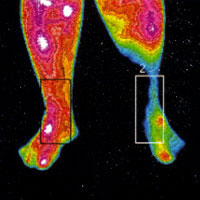
Chronic pain and its cause is one of the most difficult diagnostic problems plaguing physicians today. Frequently patient’s tests do not correlate with their symptoms. Individuals with symptoms related to a spinal nerve disorder may have more than one cause for their problem. The combined use of anatomic and physiologic testing is common in the medical community. However, until now, the physiological test of choice has been electromyography (EMG) which studies the motor function of nerve and not its sensory component.
Thermography is a physiological test (rather than an anatomic one) that measures the autonomic nervous system. While other physiologic tests exist, they do not monitor the pathways in the same fashion as thermography. Our own Dr. Philip Getson states, “It is my opinion that thermography is the BEST diagnostic tool for the evaluation of individuals suspected of having Reflex Sympathetic Dystrophy/Complex Regional Pain Syndrome (RSD/CRPS).” In addition to the discomfort inherent in EMGs, the study does not provide adequate information which, in many cases, leads to an incomplete diagnosis. By using non-invasive (and therefore not painful) thermal imaging, even more information is available to assist us in the treatment of these individuals.

Additionally, thermal imaging can be used to monitor the effectiveness of interventional pain management techniques by using a safe, highly reproducible, sensitive, and accurate diagnostic tool. This includes the use of thermal imaging in the positioning of spinal cord stimulators, which has increased the accuracy of lead placement. Thermography can detect alterations in the heat patterns of limbs to suggest that there are damaged leads, thereby differentiating between an increased pain state and an equipment malfunction. Localization of trigger points by thermographic means has been shown to increase the effectiveness of injections into these areas.
Data is currently being collected that suggests that Thermography can predict the spread of RSD before it actually occurs, thereby allowing for the earliest possible intervention.
Thermography is also a valuable diagnostic tool in the study of Thoracic Outlet Syndrome, a group of disorders that occur when certain blood vessels or nerves are compressed. This disorder can be demonstrated in real-time or by static images to provide objective evidence of the problem and monitor any treatment that may be administered.

